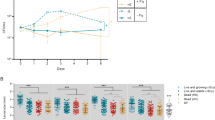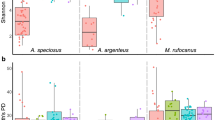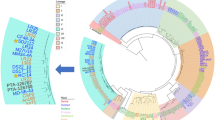Abstract
The vertebrate digestive tract, including that of humans, is the habitat to trillions of bacteria that are of significant importance to host biology and health. Although these communities are often postulated to have coevolved with their hosts, evidence is lacking, yet critical for our understanding of microbial symbiosis in vertebrates. To gain insight into the evolution of a gut symbiont, we have characterized the population genetic structure and phylogeny of Lactobacillus reuteri strains isolated from six different host species (human, mouse, rat, pig, chicken and turkey) using Amplified-Fragment Length Polymorphism (AFLP) and Multi-Locus Sequence Analysis (MLSA). The results revealed considerable genetic heterogeneity within the L. reuteri population and distinct monophyletic clades reflecting host origin but not provenance. The evolutionary patterns detected indicate a long-term association of L. reuteri lineages with particular vertebrate species and host-driven diversification. Results from a competition experiment in a gnotobiotic mouse model revealed that rodent isolates showed elevated ecological performance, indicating that evolution of L. reuteri lineages was adaptive. These findings provide evidence that some vertebrate gut microbes are not promiscuous, but have diversified into host-adapted lineages by a long-term evolutionary process, allowing the development of a highly specialized symbiosis.
Similar content being viewed by others
Log in or create a free account to read this content
Gain free access to this article, as well as selected content from this journal and more on nature.com
or
Accession codes
Accessions
GenBank/EMBL/DDBJ
References
Abbas Hilmi HT, Surakka A, Apajalahti J, Saris PE . (2007). Identification of the most abundant Lactobacillus species in the crop of 1- and 5-week-old broiler chickens. Appl Environ Microbiol 73: 7867–7873.
Brooks SP, McAllister M, Sandoz M, Kalmokoff ML . (2003). Culture-independent phylogenetic analysis of the faecal flora of the rat. Can J Microbiol 49: 589–601.
Callaway TR, Edrington TS, Anderson RC, Byrd JA, Nisbet DJ . (2008). Gastrointestinal microbial ecology and the safety of our food supply as related to Salmonella. J Anim Sci 86: E163–E172.
Cani PD, Neyrinck AM, Fava F, Knauf C, Burcelin RG, Tuohy KM et al. (2007). Selective increases of bifidobacteria in gut microflora improve high-fat-diet-induced diabetes in mice through a mechanism associated with endotoxaemia. Diabetologia 50: 2374–2383.
Carbajal N, Casas IA, Dobrogosz WJ . (1999). Effect of host-specific Lactobacillus reuteri on ileal tissue development in gnotobiotic BALB/c mice. Microbial Ecol Health Dis 11: (Abstract) 184.
Casas IA, Dobrogosz WJ . (2000). Validation of the probiotic concept: Lactobacillus reuteri confers broad-spectrum protection against disease in humans and animals. Microb Ecol Health Dis 12: 247–285.
Cerutti A, Rescigno M . (2008). The biology of intestinal immunoglobulin A responses. Immunity 28: 740–750.
Claus SP, Tsang TM, Wang Y, Cloarec O, Skordi E, Martin FP et al. (2008). Systemic multicompartmental effects of the gut microbiome on mouse metabolic phenotypes. Mol Syst Biol 4: 219.
Cohan FM, Perry EB . (2007). A systematics for discovering the fundamental units of bacterial diversity. Curr Biol 17: R373–R386.
Dal Bello F, Walter J, Hammes WP, Hertel C . (2003). Increased complexity of the species composition of lactic acid bacteria in human feces revealed by alternative incubation condition. Microb Ecol 45: 455–463.
Dale C, Moran NA . (2006). Molecular interactions between bacterial symbionts and their hosts. Cell 126: 453–465.
Dethlefsen L, McFall-Ngai M, Relman DA . (2007). An ecological and evolutionary perspective on human-microbe mutualism and disease. Nature 449: 811–818.
Didelot X, Falush D . (2007). Inference of bacterial microevolution using multilocus sequence data. Genetics 175: 1251–1266.
Doolittle WF, Zhaxybayeva O . (2009). On the origin of prokaryotic species. Genome Res 19: 744–756.
Fraser C, Hanage WP, Spratt BG . (2005). Neutral microepidemic evolution of bacterial pathogens. Proc Natl Acad Sci USA 102: 1968–1973.
Fraser C, Hanage WP, Spratt BG . (2007). Recombination and the nature of bacterial speciation. Science 315: 476–480.
Hanage WP, Fraser C, Spratt BG . (2005). Fuzzy species among recombinogenic bacteria. BMC Biol 3: 6.
Hooper LV, Gordon JI . (2001). Commensal host-bacterial relationships in the gut. Science 292: 1115–1118.
Huson DH . (1998). SplitsTree: analyzing and visualizing evolutionary data. Bioinformatics 14: 68–73.
Koeppel A, Perry EB, Sikorski J, Krizanc D, Warner A, Ward DM et al. (2008). Identifying the fundamental units of bacterial diversity: a paradigm shift to incorporate ecology into bacterial systematics. Proc Natl Acad Sci USA 105: 2504–2509.
Lawrence JG, Ochman H . (1998). Molecular archaeology of the Escherichia coli genome. Proc Natl Acad Sci USA 95: 9413–9417.
Leser TD, Amenuvor JZ, Jensen TK, Lindecrona RH, Boye M, Moller K . (2002). Culture-independent analysis of gut bacteria: the pig gastrointestinal tract microbiota revisited. Appl Environ Microbiol 68: 673–690.
Ley RE, Backhed F, Turnbaugh P, Lozupone CA, Knight RD, Gordon JI . (2005). Obesity alters gut microbial ecology. Proc Natl Acad Sci USA 102: 11070–11075.
Ley RE, Hamady M, Lozupone C, Turnbaugh PJ, Ramey RR, Bircher JS et al. (2008a). Evolution of mammals and their gut microbes. Science 320: 1647–1651.
Ley RE, Lozupone CA, Hamady M, Knight R, Gordon JI . (2008b). Worlds within worlds: evolution of the vertebrate gut microbiota. Nat Rev Microbiol 6: 776–788.
Ley RE, Peterson DA, Gordon JI . (2006). Ecological and evolutionary forces shaping microbial diversity in the human intestine. Cell 124: 837–848.
Li M, Wang B, Zhang M, Rantalainen M, Wang S, Zhou H et al. (2008). Symbiotic gut microbes modulate human metabolic phenotypes. Proc Natl Acad Sci USA 105: 2117–2122.
Lin JH-C, Savage DC . (1984). Host specificity of the colonization of murine gastric epithelium by lactobacilli. FEMS Microbiol Letters 24: 67–71.
Madsen KL, Doyle JS, Jewell LD, Tavernini MM, Fedorak RN . (1999). Lactobacillus species prevents colitis in interleukin 10 gene-deficient mice. Gastroenterology 116: 1107–1114.
Molin G, Andersson R, Ahrne S, Lonner C, Marklinder I, Johansson ML et al. (1992). Effect of fermented oatmeal soup on the cholesterol level and the Lactobacillus colonization of rat intestinal mucosa. Antonie Van Leeuwenhoek 61: 167–173.
Moller PL, Paerregaard A, Gad M, Kristensen NN, Claesson MH . (2005). Colitic scid mice fed Lactobacillus spp. show an ameliorated gut histopathology and an altered cytokine profile by local T cells. Inflamm Bowel Dis 11: 814–819.
Moran NA . (2006). Symbiosis. Curr Biol 16: R866–R871.
Moran NA, McCutcheon JP, Nakabachi A . (2008). Genomics and evolution of heritable bacterial symbionts. Annu Rev Genet 42: 165–190.
Nicholson JK, Holmes E, Wilson ID . (2005). Gut microorganisms, mammalian metabolism and personalized health care. Nat Rev Microbiol 3: 431–438.
Ochman H, Elwyn S, Moran NA . (1999). Calibrating bacterial evolution. Proc Natl Acad Sci USA 96: 12638–12643.
Pena JA, Rogers AB, Ge Z, Ng V, Li SY, Fox JG et al. (2005). Probiotic Lactobacillus spp. diminish Helicobacter hepaticus-induced inflammatory bowel disease in interleukin-10-deficient mice. Infect Immun 73: 912–920.
Peterson DA, McNulty NP, Guruge JL, Gordon JI . (2007). IgA response to symbiotic bacteria as a mediator of gut homeostasis. Cell Host Microbe 2: 328–339.
Rakoff-Nahoum S, Paglino J, Eslami-Varzaneh F, Edberg S, Medzhitov R . (2004). Recognition of commensal microflora by toll-like receptors is required for intestinal homeostasis. Cell 118: 229–241.
Rawls JF, Samuel BS, Gordon JI . (2004). Gnotobiotic zebrafish reveal evolutionarily conserved responses to the gut microbiota. Proc Natl Acad Sci USA 101: 4596–4601.
Reuter G . (2001). The Lactobacillus and Bifidobacterium microflora of the human intestine: composition and succession. Curr Issues Intest Microbiol 2: 43–53.
Rosenfeldt V, Benfeldt E, Nielsen SD, Michaelsen KF, Jeppesen DL, Valerius NH et al. (2003). Effect of probiotic Lactobacillus strains in children with atopic dermatitis. J Allergy Clin Immunol 111: 389–395.
Round JL, Mazmanian SK . (2009). The gut microbiota shapes intestinal immune responses during health and disease. Nat Rev Immunol 9: 313–323.
Salzman NH, de Jong H, Paterson Y, Harmsen HJ, Welling GW, Bos NA . (2002). Analysis of 16S libraries of mouse gastrointestinal microflora reveals a large new group of mouse intestinal bacteria. Microbiology 148: 3651–3660.
Savage DC . (1972). Associations and physiological interactions of indigenous microorganisms and gastrointestinal epithelia. Am J Clin Nutr 25: 1372–1379.
Savino F, Pelle E, Palumeri E, Oggero R, Miniero R . (2007). Lactobacillus reuteri (American Type Culture Collection Strain 55730) versus simethicone in the treatment of infantile colic: a prospective randomized study. Pediatrics 119: e124–e130.
Schell MA, Karmirantzou M, Snel B, Vilanova D, Berger B, Pessi G et al. (2002). The genome sequence of Bifidobacterium longum reflects its adaptation to the human gastrointestinal tract. Proc Natl Acad Sci USA 99: 14422–14427.
Schreiber O, Petersson J, Phillipson M, Perry M, Roos S, Holm L . (2009). Lactobacillus reuteri prevents colitis by reducing P-selectin-associated leukocyte- and platelet-endothelial cell interactions. Am J Physiol Gastrointest Liver Physiol 296: G534–G542.
Shornikova AV, Casas IA, Isolauri E, Mykkanen H, Vesikari T . (1997). Lactobacillus reuteri as a therapeutic agent in acute diarrhea in young children. J Pediatr Gastroenterol Nutr 24: 399–404.
Spratt BG, Hanage WP, Feil EJ . (2001). The relative contributions of recombination and point mutation to the diversification of bacterial clones. Curr Opin Microbiol 4: 602–606.
Suerbaum S, Josenhans C . (2007). Helicobacter pylori evolution and phenotypic diversification in a changing host. Nat Rev Microbiol 5: 441–452.
Tannock GW . (1992). Lactic microbiota of pigs, mice and rats. In: Wood BJB (ed). The Lactic Acid Bacteria in Health and Disease. Elsevier Applied Science: London, pp 21–48.
Tannock GW, Fuller R, Pedersen K . (1990). Lactobacillus succession in the piglet digestive tract demonstrated by plasmid profiling. Appl Environ Microbiol 56: 1310–1316.
Tannock GW, Miller JR, Savage DC . (1984). Host specificity of filamentous, segmented microorganisms adherent to the small bowel epithelium in mice and rats. Appl Environ Microbiol 47: 441–442.
Walter J . (2008). Ecological role of lactobacilli in the gastrointestinal tract: implications for fundamental and biomedical research. Appl Environ Microbiol 74: 4985–4996.
Walter J, Loach DM, Alqumber M, Rockel C, Hermann C, Pfitzenmaier M et al. (2007). D-alanyl ester depletion of teichoic acids in Lactobacillus reuteri 100-23 results in impaired colonization of the mouse gastrointestinal tract. Environ Microbiol 9: 1750–1760.
Weizman Z, Asli G, Alsheikh A . (2005). Effect of a probiotic infant formula on infections in child care centers: comparison of two probiotic agents. Pediatrics 115: 5–9.
Wilson DJ, Gabriel E, Leatherbarrow AJ, Cheesbrough J, Gee S, Bolton E et al. (2009). Rapid evolution and the importance of recombination to the gastroenteric pathogen Campylobacter jejuni. Mol Biol Evol 26: 385–397.
Xu J, Bjursell MK, Himrod J, Deng S, Carmichael LK, Chiang HC et al. (2003). A genomic view of the human-Bacteroides thetaiotaomicron symbiosis. Science 299: 2074–2076.
Xu J, Mahowald MA, Ley RE, Lozupone CA, Hamady M, Martens EC et al. (2007). Evolution of symbiotic bacteria in the distal human intestine. PLoS Biol 5: e156.
Acknowledgements
This study would not have been possible without the generous contributions of well characterized strains from many colleagues (the names are provided in the Supplementary information section). We further thank Dr Xavier Didelot (University of Warwick, Coventry, UK) for very helpful discussions and advice in the application of the ClonalFrame software. We are grateful to Drs Sheila Scheideler, Merlyn Nielsen and Thomas Burkey (University of Nebraska-Lincoln, USA) for the provision of gut samples from chicken, mice and pig. We thank Jaehyoung Kim, Inés Martínez, Christi Toa and Ryan Talley (University of Nebraska-Lincoln, USA) for excellent technical support. This work was funded by grants of the University of Nebraska and through support of BioGaia AB, Sweden.
Author information
Authors and Affiliations
Corresponding author
Additional information
Supplementary Information accompanies the paper on The ISME Journal website (http://www.nature.com/ismej)
Supplementary information
Rights and permissions
About this article
Cite this article
Oh, P., Benson, A., Peterson, D. et al. Diversification of the gut symbiont Lactobacillus reuteri as a result of host-driven evolution. ISME J 4, 377–387 (2010). https://doi.org/10.1038/ismej.2009.123
Received:
Revised:
Accepted:
Published:
Issue date:
DOI: https://doi.org/10.1038/ismej.2009.123
Keywords
This article is cited by
-
A phylogenomic analysis of Limosilactobacillus reuteri reveals ancient and stable evolutionary relationships with rodents and birds and zoonotic transmission to humans
BMC Biology (2023)
-
Evaluation of Potential Probiotic Properties of Lactobacillus and Bacillus Strains Derived from Various Sources for Their Potential Use in Swine Feeding
Probiotics and Antimicrobial Proteins (2023)
-
Bioinformatics and its role in the study of the evolution and probiotic potential of lactic acid bacteria
Food Science and Biotechnology (2023)
-
Distinct B cell subsets in Peyer’s patches convey probiotic effects by Limosilactobacillus reuteri
Microbiome (2021)
-
Integrated Phenotypic-Genotypic Analysis of Candidate Probiotic Weissella Cibaria Strains Isolated from Dairy Cows in Kuwait
Probiotics and Antimicrobial Proteins (2021)



